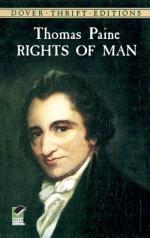
|
| Name: _________________________ | Period: ___________________ |
This test consists of 15 multiple choice questions and 5 short answer questions.
Multiple Choice Questions
1. How long after the first part of Rights of Man was Part Two published?
(a) Two years.
(b) Two months.
(c) One year.
(d) One month.
2. What style was Part One of Rights of Man written in by Paine?
(a) Traditional.
(b) Provoking.
(c) Educational.
(d) Popular.
3. How did Paine describe the picture of corporate towns in Ways and Means of Improving the Conditions of Europe?
(a) Chaos and oppression.
(b) Decay and chaos.
(c) Decay and oppression.
(d) Decay, chaos and oppression.
4. What was Paine's opinion of Burke's new work when he wrote Part Two of Rights of Man?
(a) He did not think much of it.
(b) He did not read it.
(c) He thought is was a slight improvement.
(d) He thought it was worse than before.
5. How many counties did Pennsylvania initially have before the American Constitution was formed?
(a) Eight.
(b) Twelve.
(c) Ten.
(d) Fourteen.
6. As Paine wrote in Part Two of Rights of Man, what did the American Revolution put into practice for the first time?
(a) Democratic theory.
(b) Realistic theory.
(c) Less government laws.
(d) More government laws.
7. Because the English government was undisciplined in Paine's opinion, what were they too preoccupied with?
(a) Maintaining the laws.
(b) Taxation.
(c) Changing the laws.
(d) Foreign affairs.
8. Who did Paine emphasize was the rightful owner of the Constitution?
(a) Neither the people nor the government.
(b) The government.
(c) The people and the government.
(d) The people.
9. According to Paine in Of Constitutions, how many representative bodies should a government have?
(a) Three.
(b) One.
(c) Four.
(d) Two.
10. When in 1174 did Congress meet to offer recommendations about the new Constitution?
(a) November.
(b) August.
(c) February.
(d) September.
11. What did Paine say was crucial to a good constitution at the end of Of Constitutions?
(a) The power to understand it.
(b) The power to believe in it.
(c) The power to enforce it.
(d) The power to revise it.
12. What was the compact between the people of the United States that Paine mentioned in Of Constitutions?
(a) To develop a system based on laws.
(b) To create and sustain a government.
(c) To create and sustain a philosophy.
(d) To develop a system based on taxes.
13. Who did Paine contend that a monarchy was maintained to amuse?
(a) The rich.
(b) The poor.
(c) The gullible.
(d) The stupid.
14. Which words did Paine use to depict the costs of the monarchy in Ways and Means of Improving the Conditions of Europe?
(a) Obscene and unqualified.
(b) Unqualified and unexplained.
(c) Obscene, unexplained and insane.
(d) Obscene and insane.
15. What forms of objection were there to the Articles of Confederation?
(a) Pamphlets, but not publications.
(b) Publications, but not pamphlets.
(c) Neither pamphlets nor publications.
(d) Pamphlets and publications.
Short Answer Questions
1. In proportion to the poor, what kind of taxes did Paine think the Peers should have paid?
2. What concern did many people in the states have about the newly ratified Constitution?
3. Using his own life experiences as proof of his expertise, what did Paine think the young people of Europe needed?
4. Using history to support his opinion, what did Paine find unsurprising about how governments began?
5. How did Paine describe the idea of bureaucrats managing trade properly?
|
This section contains 548 words (approx. 2 pages at 300 words per page) |

|




